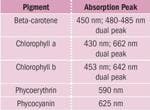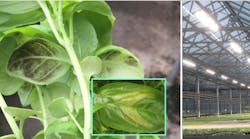This article was published in the September 2012 issue of LEDs Magazine.
View the Table of Contents and download the PDF file of the complete September 2012 issue, or view the E-zine version in your browser.
+++++
Solid-state lighting (SSL) has shown great promise in meeting the demands of energy efficiency in lighting systems with the potential to control energy costs, minimize environmental impacts, and improve energy independence. And while phosphor-converted white LED have found their way into many general-illumination applications, monochromatic/colored LEDs are also used in a number of applications throughout the architectural, entertainment and automotive segments. Monochromatic LEDs emit light at specific wavelengths and offer optimal light output that could benefit an even broader spectrum of promising new application areas. Let’s discuss potential applications in plant growth or horticulture, aquarium lighting, and general lighting with specific benefits for wildlife.
Plant growth
Plants use light as a source of energy to carry out the process of photosynthesis. Photosynthesis is the primary chemical reaction that influences the growth and survivability of the plant. Different wavelengths in the spectrum of light influence various aspects of plant growth such as the size of the plant, germination process, flowering, and vegetation. In addition to the quality of light, plant cultivation is also influenced by various other factors, such as soil quality, water availability, and climatic conditions.
Cultivating plants in a greenhouse environment allows for control of all the elements that influence the growth of the plant. Within a greenhouse, it is possible to cultivate plants in locations and at times when climatic conditions would adversely affect them. The artificial lighting used in a greenhouse is one of the most critical elements that affects the growth and morphology of plants.
The artificial light in a greenhouse offers several advantages, such as: allowing growth during times of too little sunshine or shorter days; allowing for growth in multiple layers resulting in higher yields; allowing lighting from underneath or inside plants; making it possible to fit more plants into a given size of greenhouse; and allowing for faster growth by supplementing the sunshine available.
Enhancing photosynthesis
The process of photosynthesis primarily takes place in the chloroplasts which are located in the leaves of the plants, specifically using a pair of green pigments called chlorophyll. The chlorophyll, along with several other pigments such as beta-carotene, are organized in clusters and are involved in the light reaction. Each of these different colored pigments can absorb a different wavelength of light and pass its energy to the central chlorophyll molecule to carry out the process of photosynthesis.
High-pressure sodium (HPS) lamps are the most widely used supplemental lighting sources for greenhouses today. HPS lamps, although efficient in converting supplied electrical power to light output, have a spectral energy that emits in the yellow-orange part of the spectrum and are deficient in blue and red parts of the spectrum which are the key regions for photosynthetic activity. Therefore, most of the spectral energy emitted by these lamps is wasted and not utilized by the plants for photosynthetic activity.
Deficiencies in legacy sources
In addition, HPS lamps radiate high amounts of heat that increases the temperature of greenhouses, adding to higher energy consumption. Metal-halide (MH) and compact-fluorescent lamps produce more light in the blue region of the spectrum and not enough in the red and far-red regions.
Monochromatic LEDs tuned to specific wavelengths to match the absorption peaks of the photosynthetic pigments can create an ideal environment for plant cultivation (Fig 1). Fig. 2 shows the spectral distribution of Osram LEDs that match the peaks. LEDs are also more efficient in the conversion of electrical power to light in the photosynthetically active region (PAR), ranging from 400-700 nm, than any traditional light source.
Of course LEDs bring many of the same advantages to horticultural lighting that they do to general illumination. LEDs have long lifetimes as compared to traditional lighting sources, which results in lower maintenance costs. Also, the spectral output of the light could be tuned using LEDs of different wavelengths to deliver optimum growth and energy savings for a particular species of plant.
Algae growth
Now let’s move on to an application in algae growth. Microalgae have shown great promise as a source in the production of pharmaceuticals, health foods, and chemicals. More recently there has been a renewed interest in algae for biofuel generation such as bioethanol and biodiesel as possible alternatives for fossil fuels.
There are several advantages of using algae for biofuel generation. Algae do not compete for arable land with traditional agricultural crops like corn and sugarcane. They can be cultivated in open ponds or in closed loop systems such as photobioreactors (PBRs) located on non-arable lands. Algae can grow in a wide variety of climate and water conditions. And they can potentially produce higher quantities of biofuel compared to other oil crops.
Algae are very similar to plants and perform the same chemical process of photosynthesis. Outdoor open ponds and enclosed PBRs are the most common production systems for harvesting algae. PBRs provide a more controlled environment for the growth of algae. Light cannot be stored in PBRs and is supplied continuously, which is essential for the phototropic growth of microalgae.
The growth and metabolism of algae depend on both the spectral quality and intensity of light. LEDs are an attractive alternative for artificial lighting because of their high energy efficiency at key wavelengths for the photosynthetic growth. Monochromatic LEDs with their narrow spectral bandwidth eliminate the need for filters and complex cooling systems, and offer a long life expectancy as compared to traditional lighting sources.
Turtle friendly lighting
Monochromatic LED lighting can also come into play in general lighting where the intent is to minimize the disturbance of the environment. For example, artificial night lighting can disrupt the orientation of hatchling sea turtles emerging from their nests on oceanic beaches. The evolutionary instinct of hatchling sea turtles pushes them towards the brightest source of light in view. Naturally this would be the sun or the moon, leading it towards the ocean horizon and into its new ecosystem (Fig. 4).
Instead, hatchling turtles can be attracted to the artificial light visible close to beaches such as street, building, or parking-lot lighting. Hatchlings not entering the ocean suffer high rates of mortality from exhaustion, dehydration, and predation. Several studies and field experiments have shown that the spectral energy and intensity of light to which the hatchling sea turtles are exposed plays an important role in the sea-finding mechanism of these turtles. Studies have also shown that sea turtles are more sensitive to shorter wavelengths of light as compared to longer wavelengths (>560 nm) that fall at the periphery of sea turtle vision.
The beaches of Florida, which are major rookery sites for hatchling sea turtles, have witnessed a decline in sea turtle population because of the development along the coast. To protect the endangered sea turtle populations, the Florida Fish and Wildlife Conservation Commission (FWC) has come up with guidelines for approved sea turtle lighting which includes LEDs with wavelengths greater than 560 nm.
Aquarium Lighting
Lastly let’s discuss aquarium lighting. Aquarium lighting systems have traditionally included light sources based on fluorescent, incandescent, and MH lamps. The purpose of lighting in an aquarium is to provide uniform illumination to the space underwater and to support the growth and sustenance of marine life. Lighting could also be used as a decorative element to create different scenes for the aquatic life such as moonlighting, sunrise, and sunset.
Similar to plant growth in terrestrial applications, LEDs offer optimal spectral output for growth of marine life. LED systems provide high intensity light with less radiant heat than traditional lighting sources, thereby reducing the cooling requirements. Also LED lighting systems offer higher efficiency, lower maintenance costs, and no wavelength degradation with time as experienced in fluorescent systems.
Specific LED wavelengths enhance the fluorescence and colors of certain species of corals. Shorter wavelengths around 450 nm, which also equate to higher energy, penetrate water better than longer wavelengths of light. High-color-temperature LEDs with a broad-band spectrum that simulates the appearance of sunlight with a blue spike for coral fluorescence are being widely considered for aquarium lighting. Fig. 3 shows the spectral distribution of LEDs that match the requirement. Also, LEDs are a point source of light, and as light penetrates the water and reflects with the movement of the water surface, they produce a more natural and eye-catching shimmer effect in the aquarium.
LEDs that emit specific wavelengths that alter the spectral composition of light offer exciting new possibilities. These light sources offer advantages over traditional lighting sources that go well beyond energy savings. The unique properties of monochromatic LEDs offer a potential to create an impact and apply light to areas in ways it was never thought to be possible with incumbent technologies.










